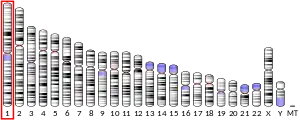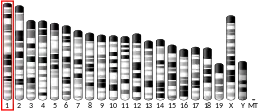Interferon-inducible protein AIM2 also known as absent in melanoma 2 or simply AIM2 is a protein that in humans is encoded by the AIM2 gene.[5][6]
AIM2 is a cytoplasmic sensor found in hematopoietic cells that recognizes the presence of double-stranded DNA (dsDNA) of microbial or host cellular origin.[7] AIM2-like receptor (ALR) family was founded on AIM2 and now consists of four members in human genome.[8] Activated AIM2 recruits apoptosis-associated speck-like protein containing a CARD (ASC), resulting in caspase-1 binding, and forming of AIM2 inflammasome. This signaling contributes to the defense against bacterial and viral DNA.
Structure
Proteins belonging to ALR family usually contain an N-terminal pyrin (PYD) domain, and one or two HIN domains. AIM2 consists of two domains connected through a long linker: an N-terminal PYD domain (amino acids 1-87), and a C-terminal HIN-200 domain (amino acids 138–337). The PYD domain mediates homotypic protein-protein interaction, while the HIN domain binds to DNA with its two tandem oligonucleotide/oligosaccharide binding (OB) folds.[9]
Function
AIM2 is a component of the innate immune system that functions as a cytoplasmic dsDNA sensor playing a role in antiviral and antibacterial defenses, as well as in autoimmune diseases involving self DNA. Together with the adaptor ASC protein AIM2 forms a caspase-1 activating complex known as the AIM2 inflammasome.
The first step in the formation of AIM2 inflammasome is DNA binding. The HIN domain of AIM2 binds to both strands of B-form dsDNA (either viral, bacterial, or even host) in a sequence-independent manner. However, the DNA sequence must be at least 80 base pairs in length.[10] The interaction is mainly electrostatic, where positively charged amino acid residues are coordinating with phosphates and sugar moieties on DNA backbone. Binding of dsDNA displaces PYD domain, which then engages the downstream inflammasome adaptor protein ASC through homotypic PYD-PYD interactions.[11] ASC is a bipartite PYD-CARD-containing protein. CARD domain of ASC recruits procaspase-1 (CARD-CARD interaction) to the complex creating the basic structural elements of the AIM2 inflammasome. Caspase-1 autoactivates and processes cleavage of pro-IL-1β, pro-IL-18, and gasdermin D. The N-terminal fragment of gasdermin D induces pyroptosis that allows mature cytokines IL-1β, and IL-18 to be released from the cell.
Regulation
Regulation of inflammasome assembly is essential for cellular homeostasis maintenance. AIM2 activation is inhibited by the mouse protein p202 that consists of two HIN domains and lacks the PYD. ASC protein is not recruited due to the absence of PYD domain. The HIN1 domain binds to DNA, whereas HIN2 domain interacts with AIM2. HIN2 domain does not block the DNA binding surface of AIM2, hence, DNA binding affinity of AIM2 remains unaffected. It is believed that binding of p202 to DNA and AIM2 might attain a balance between host defense and pathological DNA-induced inflammation. When both p202 and AIM2 are present in equal amounts, there is a competition for dsDNA binding.[12]
A novel transcript isoform of human IFI16-designated IFI16-β has been also shown to inhibit the AIM2 inflammasome assembly. Its domain structure is similar to that of mouse p202 as it contains two HIN domains. Analogously it interacts with AIM2, competes in dsDNA binding, and disrupts ASC recruitment.[13] According to studies of p202 and IFI16-β, it appears that proteins expressing two HIN domains bind to dsDNA more robustly than proteins containing a single HIN domain.[14]
Regarding post-translational modifications, there is limited knowledge. However, it has been reported that TRIM11 binds AIM2 and leads to its degradation. Hence, it might be a negative regulator of the AIM2 inflammasome.[15]
Clinical relevance
A broad range of microbes is sensed by AIM2, leading to protective inflammasome-mediated host responses. Recent publications have shown that AIM2 inflammasome also plays roles in non-infectious diseases.
Infection
Bacteria
Bacterial DNA is released into cytoplasm during infection of a host cell, where it is recognized by AIM2 and other cytoplasmic DNA sensors. AIM2 has been shown to recognize a number of pathogenic bacteria – Francisella tularensis, Listeria monocytogenes, Streptococcus pneumoniae, Mycobacterium species, Porphyromonas gingivalis, Staphylococcus aureus, Brucella abortus, and Chlamydia muridarum.[7] Type I IFNs augment the activity of the AIM2 inflammasome during bacterial infection.[16][17]
Viruses
AIM2 inflammasome plays a crucial role in the defense against viral infection as genetic material from DNA viruses that enter the cytoplasm can be recognized. However, AIM2 does not respond to all DNA viruses. To date, only mouse cytomegalovirus (MCMV), vaccinia virus, and human papillomaviruses have been observed to induce AIM2 inflammasome.[7]
Other pathogens
Moreover, AIM2 has been shown to mediate host defense to the fungal pathogen Aspergillus fumigatus[18] and the protozoan Plasmodium berghei.[19]
Cancer
The gene encoding AIM2 was originally isolated from human melanoma cells.[5] AIM2 has been shown to suppress the development of tumors. However, the expression of AIM2 was observed to be differential in a range of tumor tissues suggesting that it may have unique roles in different cancer types. Recent studies investigating AIM2 function in cancer highlight the potential role of therapies inhibiting the AKT pathway in the treatment of cancer associated with AIM2 mutations.[7]
Inflammatory, autoimmune, and other pathological conditions
The accumulation of DNA in the cytosol can serve as an endogenous danger signal triggering AIM2 inflammasome. Aberrant activation of AIM2 from self-DNA is a key driver of inflammatory and autoimmune diseases. Elevated levels of AIM2 expression are found in skin cells from people with acute and chronic skin conditions, including psoriasis, atopic dermatitis, and contact dermatitis. Increased expression of AIM2 has also been reported in patients with inflammatory bowel disease and liver inflammation. Moreover, AIM2 might be involved in inflammation and cell death of the brain.[7] In systemic lupus erythematosus, lysosome dysfunction allows DNA to gain access to the cytosol and activate AIM2 resulting in increased type 1 interferon production.[20]
References
- 1 2 3 GRCh38: Ensembl release 89: ENSG00000163568 - Ensembl, May 2017
- 1 2 3 GRCm38: Ensembl release 89: ENSMUSG00000037860 - Ensembl, May 2017
- ↑ "Human PubMed Reference:". National Center for Biotechnology Information, U.S. National Library of Medicine.
- ↑ "Mouse PubMed Reference:". National Center for Biotechnology Information, U.S. National Library of Medicine.
- 1 2 DeYoung KL, Ray ME, Su YA, Anzick SL, Johnstone RW, Trapani JA, et al. (July 1997). "Cloning a novel member of the human interferon-inducible gene family associated with control of tumorigenicity in a model of human melanoma". Oncogene. 15 (4): 453–7. doi:10.1038/sj.onc.1201206. PMID 9242382. S2CID 11152041.
- ↑ "Entrez Gene: AIM2 absent in melanoma 2".
- 1 2 3 4 5 Man SM, Karki R, Kanneganti TD (February 2016). "AIM2 inflammasome in infection, cancer, and autoimmunity: Role in DNA sensing, inflammation, and innate immunity". European Journal of Immunology. 46 (2): 269–80. doi:10.1002/eji.201545839. PMC 4758349. PMID 26626159.
- ↑ Cridland JA, Curley EZ, Wykes MN, Schroder K, Sweet MJ, Roberts TL, et al. (August 2012). "The mammalian PYHIN gene family: phylogeny, evolution and expression". BMC Evolutionary Biology. 12 (1): 140. Bibcode:2012BMCEE..12..140C. doi:10.1186/1471-2148-12-140. PMC 3458909. PMID 22871040.
- ↑ Wang B, Yin Q (December 2017). "AIM2 inflammasome activation and regulation: A structural perspective". Journal of Structural Biology. 200 (3): 279–282. doi:10.1016/j.jsb.2017.08.001. PMC 5733693. PMID 28813641.
- ↑ Jin T, Perry A, Jiang J, Smith P, Curry JA, Unterholzner L, et al. (April 2012). "Structures of the HIN domain:DNA complexes reveal ligand binding and activation mechanisms of the AIM2 inflammasome and IFI16 receptor". Immunity. 36 (4): 561–71. doi:10.1016/j.immuni.2012.02.014. PMC 3334467. PMID 22483801.
- ↑ Morrone SR, Matyszewski M, Yu X, Delannoy M, Egelman EH, Sohn J (July 2015). "Assembly-driven activation of the AIM2 foreign-dsDNA sensor provides a polymerization template for downstream ASC". Nature Communications. 6 (1): 7827. Bibcode:2015NatCo...6.7827M. doi:10.1038/ncomms8827. PMC 4525163. PMID 26197926.
- ↑ Ru H, Ni X, Zhao L, Crowley C, Ding W, Hung LW, et al. (June 2013). "Structural basis for termination of AIM2-mediated signaling by p202". Cell Research. 23 (6): 855–8. doi:10.1038/cr.2013.52. PMC 3674390. PMID 23567559.
- ↑ Wang PH, Ye ZW, Deng JJ, Siu KL, Gao WW, Chaudhary V, et al. (October 2018). "Inhibition of AIM2 inflammasome activation by a novel transcript isoform of IFI16". EMBO Reports. 19 (10). doi:10.15252/embr.201845737. PMC 6172465. PMID 30104205.
- ↑ Sharma M, de Alba E (January 2021). "Structure, Activation and Regulation of NLRP3 and AIM2 Inflammasomes". International Journal of Molecular Sciences. 22 (2): 872. doi:10.3390/ijms22020872. PMC 7830601. PMID 33467177.
- ↑ Yang J, Liu Z, Xiao TS (January 2017). "Post-translational regulation of inflammasomes". Cellular & Molecular Immunology. 14 (1): 65–79. doi:10.1038/cmi.2016.29. PMC 5214939. PMID 27345727.
- ↑ Henry T, Brotcke A, Weiss DS, Thompson LJ, Monack DM (May 2007). "Type I interferon signaling is required for activation of the inflammasome during Francisella infection". The Journal of Experimental Medicine. 204 (5): 987–94. doi:10.1084/jem.20062665. PMC 2118578. PMID 17452523.
- ↑ Fang R, Hara H, Sakai S, Hernandez-Cuellar E, Mitsuyama M, Kawamura I, Tsuchiya K (June 2014). Camilli A (ed.). "Type I interferon signaling regulates activation of the absent in melanoma 2 inflammasome during Streptococcus pneumoniae infection". Infection and Immunity. 82 (6): 2310–7. doi:10.1128/IAI.01572-14. PMC 4019145. PMID 24643540.
- ↑ Karki R, Man SM, Malireddi RK, Gurung P, Vogel P, Lamkanfi M, Kanneganti TD (March 2015). "Concerted activation of the AIM2 and NLRP3 inflammasomes orchestrates host protection against Aspergillus infection". Cell Host & Microbe. 17 (3): 357–368. doi:10.1016/j.chom.2015.01.006. PMC 4359672. PMID 25704009.
- ↑ Kalantari P, DeOliveira RB, Chan J, Corbett Y, Rathinam V, Stutz A, et al. (January 2014). "Dual engagement of the NLRP3 and AIM2 inflammasomes by plasmodium-derived hemozoin and DNA during malaria". Cell Reports. 6 (1): 196–210. doi:10.1016/j.celrep.2013.12.014. PMC 4105362. PMID 24388751.
- ↑ Monteith AJ, Kang S, Scott E, Hillman K, Rajfur Z, Jacobson K, et al. (April 2016). "Defects in lysosomal maturation facilitate the activation of innate sensors in systemic lupus erythematosus". Proceedings of the National Academy of Sciences of the United States of America. 113 (15): E2142-51. Bibcode:2016PNAS..113E2142M. doi:10.1073/pnas.1513943113. PMC 4839468. PMID 27035940.
Further reading
- Landolfo S, Gariglio M, Gribaudo G, Lembo D (1999). "The Ifi 200 genes: an emerging family of IFN-inducible genes". Biochimie. 80 (8–9): 721–8. doi:10.1016/S0300-9084(99)80025-X. PMID 9865494.
- Woerner SM, Kloor M, Schwitalle Y, Youmans H, von Doeberitz M, Gebert J, Dihlmann S (December 2007). "The putative tumor suppressor AIM2 is frequently affected by different genetic alterations in microsatellite unstable colon cancers". Genes, Chromosomes & Cancer. 46 (12): 1080–9. doi:10.1002/gcc.20493. PMID 17726700. S2CID 23562458.
- Chen IF, Ou-Yang F, Hung JY, Liu JC, Wang H, Wang SC, et al. (January 2006). "AIM2 suppresses human breast cancer cell proliferation in vitro and mammary tumor growth in a mouse model". Molecular Cancer Therapeutics. 5 (1): 1–7. doi:10.1158/1535-7163.MCT-05-0310. PMID 16432157. S2CID 2462575.
- Cresswell KS, Clarke CJ, Jackson JT, Darcy PK, Trapani JA, Johnstone RW (January 2005). "Biochemical and growth regulatory activities of the HIN-200 family member and putative tumor suppressor protein, AIM2". Biochemical and Biophysical Research Communications. 326 (2): 417–24. doi:10.1016/j.bbrc.2004.11.048. PMID 15582594.
- Liu G, Yu JS, Zeng G, Yin D, Xie D, Black KL, Ying H (2004). "AIM-2: a novel tumor antigen is expressed and presented by human glioma cells". Journal of Immunotherapy. 27 (3): 220–6. doi:10.1097/00002371-200405000-00006. PMID 15076139. S2CID 38018552.
- Choubey D, Walter S, Geng Y, Xin H (May 2000). "Cytoplasmic localization of the interferon-inducible protein that is encoded by the AIM2 (absent in melanoma) gene from the 200-gene family". FEBS Letters. 474 (1): 38–42. doi:10.1016/S0014-5793(00)01571-4. PMID 10828447.
External links
- Human AIM2 genome location and AIM2 gene details page in the UCSC Genome Browser.




